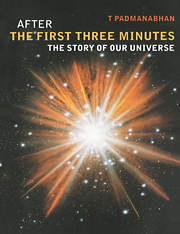7 - The universe at high redshift
Published online by Cambridge University Press: 02 November 2009
Summary
Probing the past
The discussion in the last chapter shows that most of the prominent structures in the universe have formed rather recently. In terms of redshifts we may say that galaxy formation probably took place at z < 10. Our understanding of galaxy formation could be vastly improved if we could directly observe structures during their formative phases. Remember that in the case of stars we can directly probe every feature of a stellar life cycle from birth to death; this has helped us to understand stellar evolution quite well. Can we do the same as regards galaxies?
Unfortunately, this task turns out to be very difficult. The life span of a typical star — though large by human standards — is small compared to the age of the universe. This allows one to catch the stars at different stages of their evolution. For galaxies, the timescale is much longer and so we cannot hope to find clear signals for galaxies of different ages. Secondly, the distance scales involved in extragalactic astronomy are enormously large compared to stellar physics. This introduces several observational uncertainties into the study.
In spite of all these difficulties, astronomers have made significant progress in probing the universe during its earlier phases. We saw in chapter 5 that the farther an object is the higher its redshift will be. But since light takes a finite time to travel the distance between a given object and us, what we see today in a distant object is a fossilized record of the past. Consider, for example, a galaxy which is at a distance of one billion light years.
- Type
- Chapter
- Information
- After the First Three MinutesThe Story of Our Universe, pp. 171 - 191Publisher: Cambridge University PressPrint publication year: 1998

